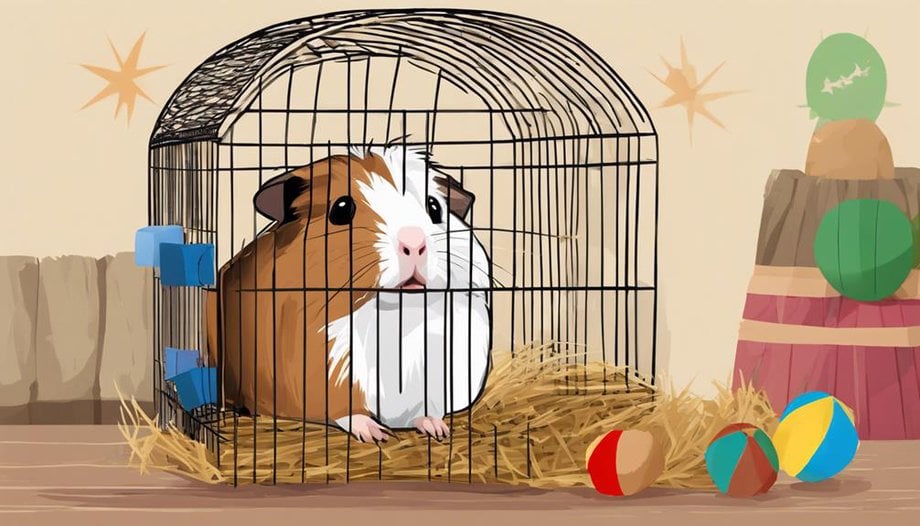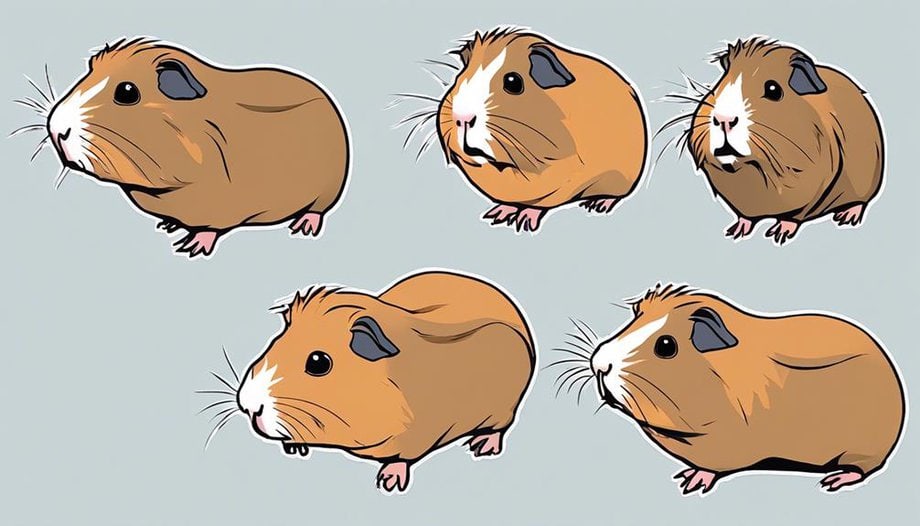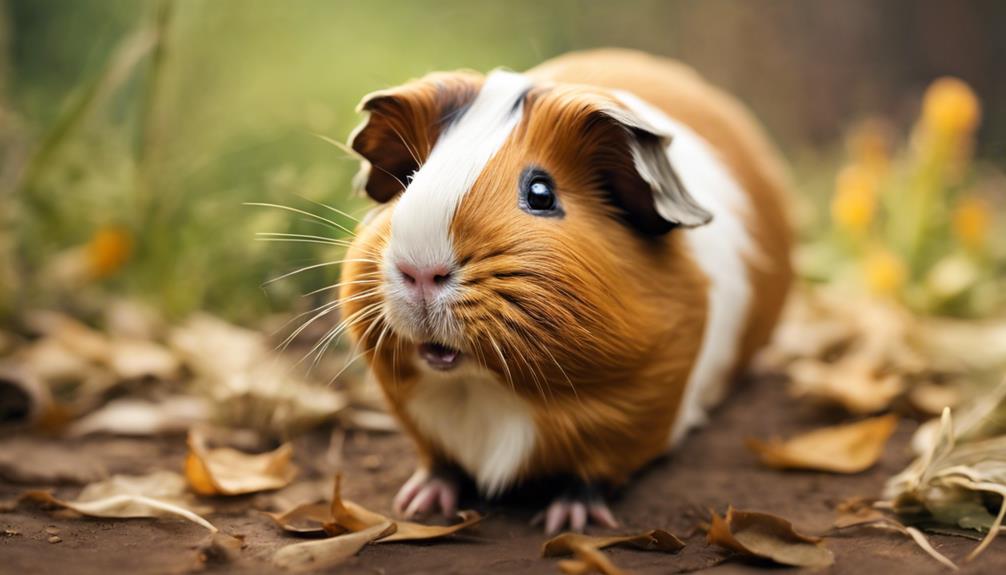Why It's Important to Understand Guinea Pig Vocalizations for Health Monitoring

Understanding guinea pig vocalizations is crucial for monitoring their health. Each sound they make can reveal important information about their well-being, helping pet owners detect potential issues early on.
By listening closely to their squeaks, purrs, and whistles, caregivers can better care for their furry companions and ensure they stay healthy.
It's a key skill for responsible pet ownership.
Key Takeaways
- Guinea pig vocalizations reveal emotions and physical states.
- Understanding sounds aids in early detection of health issues.
- Sudden pitch changes indicate potential health problems.
- Prompt veterinary care ensures well-being and treatment efficacy.
Importance of Guinea Pig Sounds
In the domain of guinea pig care, the importance of understanding their vocalizations can't be overstated. Sound interpretation is a critical aspect of monitoring the health and well-being of these small animals. Guinea pigs communicate through a variety of sounds, each carrying its own significance. By being attuned to these vocal cues, caretakers can gain valuable insights into the emotional and physical states of their furry companions.
Sound interpretation goes beyond simply hearing noises; it involves actively listening and deciphering the messages behind the squeaks, purrs, and chirps that guinea pigs produce. These vocalizations serve as a form of language for these creatures, enabling them to express pain, pleasure, fear, hunger, and more. By understanding and responding to these sounds appropriately, caregivers can address potential health issues promptly, leading to better outcomes for their beloved pets.
In essence, mastering the art of sound interpretation in guinea pigs is a fundamental skill for effective health monitoring. It allows caretakers to provide the necessary care and attention these sensitive animals require, ultimately enhancing their quality of life.
Types of Guinea Pig Vocalizations
Understanding the various types of vocalizations exhibited by guinea pigs provides important insights into their communication methods and overall well-being. Guinea pigs use different sounds to convey various messages, serving as essential communication cues for their owners.
Here are some vocalization variations commonly observed in guinea pigs:
- Wheeking: This high-pitched, repetitive sound is often associated with excitement or anticipation, commonly heard when a guinea pig expects food or attention.
- Purring: Similar to a cat's purr, guinea pigs purr when they're content and relaxed, indicating a sense of happiness and comfort.
- Chutting: This sound is characterized by short, staccato noises and is usually a sign of exploration or curiosity in guinea pigs.
- Teeth Chattering: When a guinea pig produces rapid teeth chattering sounds, it can signal annoyance, anger, or a warning to other guinea pigs.
Understanding these vocalization variations can help guinea pig owners better interpret their pets' feelings and needs accurately.
Recognizing Normal Guinea Pig Sounds

Guinea pigs communicate through a variety of sounds that reflect their emotions and needs. Understanding these vocalizations can provide valuable insights into a guinea pig's well-being and state of mind.
Normal Sound Descriptions
Recognizing normal guinea pig sounds provides valuable insight into their well-being and communication with humans. Understanding the various sounds these small creatures make is essential for interpreting their state of health. Here are some common guinea pig sounds and their health implications:
- Purring: Indicates contentment and relaxation.
- Whistling: Often a sign of excitement or anticipation.
- Chirping: Usually heard during social interactions or when exploring.
- Rumbling: Can signal dominance or be a warning to others.
Behavioral Context Understanding
Amidst the symphony of sounds emitted by guinea pigs, how can one decipher the behavioral context behind each chirp, whistle, or rumble? Understanding guinea pig vocalizations is vital in interpreting their behavioral cues and potential health indicators. By recognizing normal sounds, owners can better monitor the well-being of their furry companions. Below is a table outlining common guinea pig sounds and their possible meanings:
| Sound | Description | Behavioral Context |
|---|---|---|
| Chirping | Short, high-pitched | Content or excited |
| Whistling | Long, melodious | Seeking attention |
| Rumbling | Low, vibrating | Signaling dominance |
| Purring | Soft, continuous | Expressing pleasure |
| Teeth Chattering | Rapid, repetitive | Sign of irritation |
Understanding Guinea Pig Body Language
Interpreting the subtle cues in a guinea pig's body language is essential for understanding their emotional state and well-being. Guinea pigs communicate a lot through their body language, providing valuable insights into their needs and feelings. Here are some key points to take into account when interpreting a guinea pig's body language:
- Posture: Pay attention to how your guinea pig is standing or sitting. A hunched posture could indicate pain or discomfort.
- Eyes: The eyes of a guinea pig can convey a lot. Wide-open eyes may suggest alertness or fear, while half-closed eyes could indicate relaxation.
- Ears: The position of their ears can also provide clues. Ears perked up may signal curiosity or excitement, while flattened ears might indicate fear or aggression.
- Movements: Observe how your guinea pig moves. Rapid movements could mean they're scared, while slow and relaxed movements suggest contentment.
Understanding these non-verbal cues is critical for monitoring the wellness and emotional state of your beloved guinea pig.
Significance of Sudden Changes in Sounds

Sudden changes in guinea pig vocalizations can indicate underlying health issues or emotional distress. Paying attention to sudden pitch changes and frequency variations in their sounds can provide valuable insights into their well-being.
Understanding these shifts in vocalizations can aid in early detection of potential health problems or stressors.
Sudden Pitch Changes
Detecting abrupt changes in pitch within guinea pig vocalizations can serve as an important indicator of underlying health issues, prompting timely intervention and care. Sudden pitch changes can signal distress, discomfort, or pain in guinea pigs, highlighting the significance of closely monitoring their vocal cues.
Here are key points to take into account regarding sudden pitch changes:
- Behavioral Shifts: Guinea pigs may exhibit changes in their behavior when sudden pitch variations occur, such as increased restlessness or reduced appetite.
- Physical Examination: Promptly examining the guinea pig for any visible signs of injury or illness is essential when sudden pitch changes are detected.
- Consulting a Veterinarian: Seeking professional advice from a veterinarian can help determine the root cause of the pitch variations and provide appropriate treatment.
- Maintaining a Calm Environment: Creating a peaceful setting can aid in alleviating stressors that may be contributing to the sudden pitch changes.
Frequency Variations
When guinea pigs experience sudden changes in the frequency of their vocalizations, it provides valuable insight into their current state of well-being and health. Pitch variations and frequency shifts in their vocalizations can serve as important behavioral cues and health indicators for attentive owners.
A sudden increase or decrease in the frequency of sounds made by guinea pigs may indicate discomfort, pain, or distress. Monitoring these frequency variations can help in identifying potential health issues early on, allowing for prompt intervention and care.
Common Health Issues Reflected in Sounds
Revealing subtle clues about their well-being, guinea pig vocalizations can serve as indicators of common health issues. Understanding these sounds is important for proactive health monitoring. Here are some common health problems that can be reflected in guinea pig vocalizations:
- Respiratory Issues: Wheezing and coughing sounds may indicate respiratory problems such as infections or allergies.
- Digestive Problems: Gurgling and rumbling noises in the stomach region can signal digestive issues like gas, bloating, or an upset stomach.
- Dental Troubles: Clicking or chattering sounds while eating might suggest dental problems such as overgrown teeth or misalignment.
- Pain or Discomfort: High-pitched squeals or continuous squeaking could be a sign of pain, discomfort, or distress in your guinea pig.
Monitoring Stress Through Vocalizations

Monitoring stress levels in guinea pigs through their vocalizations provides valuable insights into their emotional well-being and overall health status. Guinea pigs exhibit various vocalization patterns that serve as stress indicators, helping attentive owners detect signs of distress early on. High-pitched squeaks, for instance, may indicate fear or discomfort, while prolonged chirping could signal loneliness or anxiety.
By actively listening to these vocal cues and observing accompanying behaviors, such as hiding or decreased appetite, caretakers can gauge the extent of stress their pets are experiencing. Understanding these communication signals is essential in creating a nurturing environment that promotes the well-being of guinea pigs.
When stress is recognized promptly, appropriate interventions can be implemented to alleviate the underlying causes and prevent further negative impacts on the animals' health. By recognizing and responding to these vocalizations, caregivers can make sure that their guinea pigs lead happy, healthy lives.
Seeking Veterinary Care When Necessary
Guinea pig owners must promptly seek veterinary care when their pets exhibit concerning vocalizations and accompanying behavioral changes, as these could indicate underlying health issues that require professional attention. Early intervention is critical in guaranteeing the well-being of these small animals.
Here are some reasons why seeking veterinary care promptly is essential:
- Timely Diagnosis: Early detection of health issues can lead to quicker treatment and better outcomes for the guinea pig.
- Prevention of Complications: Prompt treatment can prevent minor issues from escalating into more severe conditions.
- Professional Guidance: Veterinarians can provide expert advice on how to best care for the guinea pig and address any health concerns effectively.
- Peace of Mind: Seeking prompt veterinary care ensures that the guinea pig is receiving the necessary attention and care, giving the owner peace of mind.
Frequently Asked Questions
Is It Normal for Guinea Pigs to Be Silent at Times, or Should They Always Be Making Vocalizations?
It is normal for guinea pigs to be silent at times. Their vocalization patterns vary, and silence can be part of their communication cues. Understanding their silent behavior is important to interpreting their overall well-being accurately.
Can Guinea Pigs Communicate Different Emotions or Needs Through Variations in Their Vocalizations?
Guinea pigs can communicate various emotions and needs through their vocalizations. Understanding these behavioral cues is essential for bonding and training. Incorporating enrichment activities can enhance their well-being, creating a harmonious relationship between pet and owner.
Are There Any Specific Sounds or Vocalizations That Indicate a Guinea Pig Is in Pain or Distress?
In the silence between squeaks, pain indicators may hide, distress signals waiting to be heard. Guinea pigs communicate through vocalization patterns, but it's in their silent periods that their suffering may be most evident.
How Can Environmental Factors, Such as Noise Levels or Changes in Routine, Affect a Guinea Pig's Vocalizations?
Environmental factors, like noise levels or routine changes, impact guinea pig vocalizations. Behavioral changes may signal stress, affecting vocalization patterns essential for health monitoring. Understanding these cues aids in caring for these sensitive animals proactively.
Are There Any Ways to Track and Analyze a Guinea Pig's Vocalizations Over Time to Monitor Changes in Their Health or Well-Being?
Tracking trends in guinea pig vocalizations involves recording and analyzing patterns over time. By monitoring changes in their sounds, one can gain insights into the animal's health and well-being, allowing for early intervention and care.











